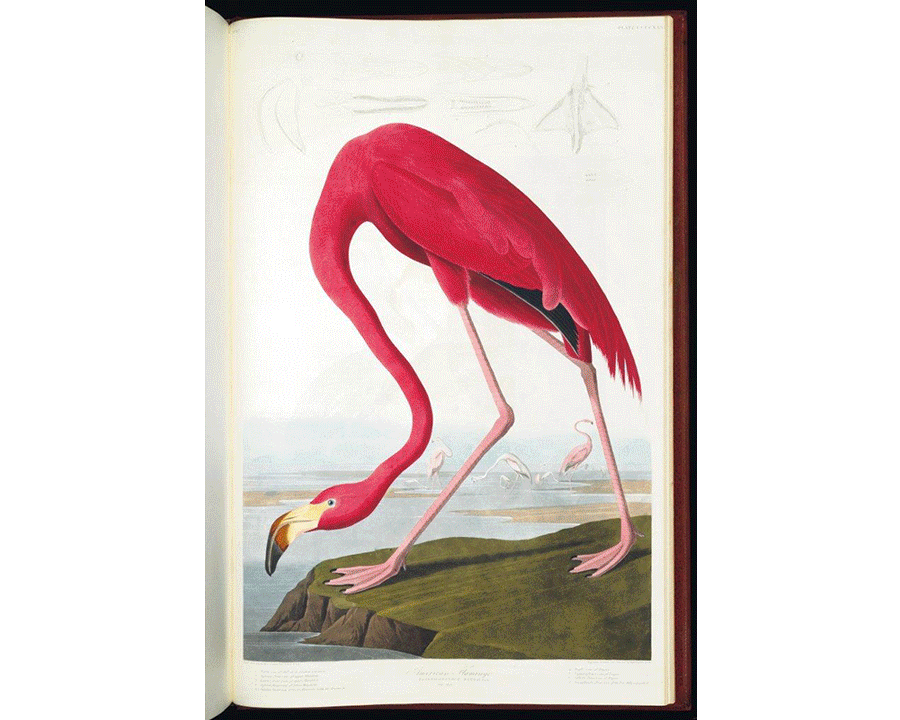On 14 June Christie's to auction the Portland Audubon
- by Bruce E. McKinney

What's to come
Christie's recently announced it will be selling the Portland copy of Audubon’s double elephant folio Birds of America that was published 1827-1838. This same set was sold in 2012 and returns to the rooms for another rendezvous with history, fate, money and the auctioneer’s hammer. It will encourage comparisons and may be a bellwether for a market that is skewing both high and low. The overall market has been in a soft decline while the best material has been rising. Audubon is the best of the best. The estimate will be $8-12 million and the proceeds go to benefit charitable conservation initiates
In an era where the biggest do best 2018 appears to be on track to be a major year for the world of rare and important books and this set may recalibrate valuation.
For the collector or institution that wants to begin their consideration here is what Christie's had to say six years ago. It’s the same set, the only difference six years.
THE EXCEPTIONALLY FINE DUKE OF PORTLAND SET OF AUDUBON'S MASTERPIECE THE BIRDS OF AMERICA -- THE FINEST COLOR-PLATE BOOK OF ORNITHOLOGY EVER PRODUCED.
AUDUBON, John James (1785-1851). The Birds of America; from Original Drawings. London: Published by the Author, 1827-1838.
4 volumes, "double-elephant" broadsheets (979/975 x 650/632 mm). Engraved title-page in each volume and 435 hand-colored, etched and aquatint plates, by William H. Lizars (Edinburgh), Robert Havell, Sr. and Robert Havell, Jr. (London), after Audubon's original life-size watercolor drawings, on J. Whatman and J. Whatman Turkey Mill paper with watermarks dated 1827-1838 (see Appendix B for watermarks on the individual sheets in this set).
First state of the title in volume I, containing 13 lines (before the addition of two extra lines listing Audubon's memberships to learned societies and without volume number). The plates in this set are arranged in order of publication (not by families) and numbered I-X, 11-14, XV, 16-100, CI-CCCCXXXV. Thus, most of the first 100 plates (Vol. I) are early states with Arabic numbering. All of the first ten plates are engraved by William Home Lizars alone, before retouching by R. Havell, Jr. For a comparison of the states of the legends on the first ten plates in this copy with Waldemar Fries' listing of the variants, in his landmark monograph on the double elephant folio, see Appendix A.
Two paper stocks were used throughout the production, both bearing the name of the English paper-maker James Whatman. William Balston, the apprentice and successor of the younger James Whatman, shared the rights to the old Whatman company and used the watermark "J Whatman"; the Hollingsworth family had the rights to the watermark "J Whatman Turkey Mill." The sheet size of the paper is known as "double elephant," measuring 39 x 29 inches, approximately the same size of the drawing paper that bears the same name.
CONDITION
A fine copy in excellent condition, with fresh, vibrant colors. Minor defects include: some occasional finger-soiling; some occasional pale show-through from offset of succeeding plates; a few plates with moderate surface bloom or bloom-spots; occasional light discoloration, foxing or spotting; the larger plates with a few instances of plate numbers, part numbers and parts of captions being obscured by the binding, shaved or cropped; a few creases, some extending beyond the platemark; some minor tears, most repaired, chiefly marginal, a few extending within the platemark.
BINDING
Size: 993 x 655 mm (39 1/8 x 25 inches). Full contemporary English crimson morocco, richly gilt, covers paneled a wide decorative roll-tooled outer border surrounding a central panel with a roll-tooled border, a stylized scallop corner-piece built up of smaller tools at each outer corner of central panel, spines in nine compartments with eight double-raised bands, two with onlaid green morocco lettering pieces, the others with a repeated richly gilt panel, board edges and turn-ins elaborately gilt, marbled paper pastedowns and free endpapers, blank flyleaves watermarked "J. Whatman 1838," stamp-signed "J. Mackenzie" on free endpapers of plate volumes (Vol. 3 with a tiny stain on fore-edge, some slight areas of darker discoloration partially due to orientation of the leather hides, some minor surface wear and abrasions skillfully restored and refurbished by James & Stuart Brockman Ltd.); plate volumes in four velvet-lined quarter leather buckram over wooden board folding boxes.
John Mackenzie (1788-ca 1850) is believed to have apprenticed in Frederich Leberecht Staggemeier's shop in the second decade of the nineteenth century. Mackenzie's independent business flourished in the second quarter of the century, during which time he held the office of bookbinder to both King George IV and King William IV. He is noted for his use of hard-grain morocco, most prominently on the natural history and color-plate books found in the Broxbourne and Grenville libraries.